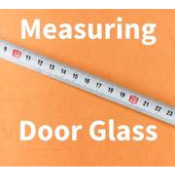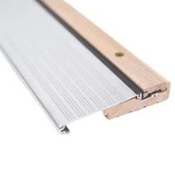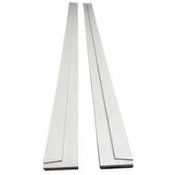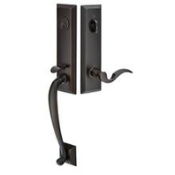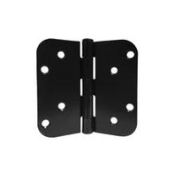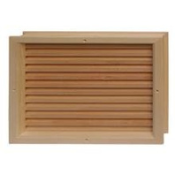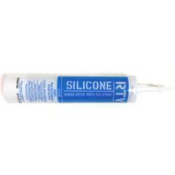Hinges Installation
Replacing hinges helps update your door's look and ensures smooth functionality. Before getting started, please review the information below carefully.
Hinge Anatomy
- Knuckles/Barrel: the round middle part of the hinge that the pin slides through. Knuckles are formed by segments coming off of each wing of the hinge
- Wing (leaf): each hinge has two wings that come together at the knuckles
- Pin: slides down through the knuckles and holds the two wings of the hinge together
- Screw hole: hinges typically have 3-5 screw holes per wing
- Screw hole pattern: also known as "screw hole spacing," this refers to the position of the screw holes on the wings of the hinge
- Pin cap: Some hinges have decorative caps that attach (usually screw on) to the top of bottom of the hinge pin
- Hinge height/width: Hinges are typically square, measuring 4" by 4" (typical for exterior residential doors), 3.5" by 3.5" (typical for residential interior doors), or 4.5" by 4.5"
- Hinge corner: Hinges typically come in 1 of 3 corner shapes. These are: square, 5/8" round radius (pictured below, roughly the shape that a quarter would fit into), and 1/4" round radius (a tighter corner than is pictured below, more like a corner that a dime would fit into).
- Mortise (hinge prep): Not a part of the hinge but the recessed cut out into the door jamb or door edge that the hinge sits into, allowing the door to close completely

Tips:
- You do not need to take the door out of the frame to replace hinges (just replace the hinges one at a time!)
- You do not need to remove hinge pins to replace your hinges
- We do not recommend painting hinges. This can impede functionality.
- If you encounter stripped out screw holes, you can try using longer screws or can use the method described in Section B to fill in screw holes with dowel rod (wood golf tees can also be used)
Section A: New hinges are the same size, corner shape, and hole pattern as existing hinges
- Tools required: Screwdriver
- Step 1: Open the door as wide as it can go
- Step 2: Start with the middle hinge and remove all of the screws from just the middle hinge. Leave the other two hinges in place.
- Step 3: Place a new hinge into the middle hinge location, making sure to orient the hinge with the pin coming down through the knuckles of the hinge (as in the picture of hinge anatomy)
- Step 4: Screw the new hinge into the middle hinge location, using the screws provided, or longer screws as needed
- Step 5: Repeat steps 2-4 for the top hinge
- Step 6: Repeat steps 2-4 for the bottom hinge
Section B: New hinges are the same size and corner shape but hole pattern differs from existing hinges
- Tools required: Screwdriver, power drill, 1/16" drill bit, 3/8" drill bit, 3/8" dowel rod (we recommend poplar wood), sand paper, small hand saw, wood glue
- Step 1: Open the door as wide as it can go
- Step 2: Start with the middle hinge and remove all of the screws from just the middle hinge. Leave the other two hinges in place.
- Step 3: Use the 3/8" drill bit to drill out the hole locations for all hinge holes on door edge and jamb (~1" deep holes, dowel rod should fit hole snugly but not overly tight)
- Step 4: Apply wood glue to end of dowel rod and insert into holes one by one, twisting to ensure glue on all sides and then using hand saw to cut off dowel rod close to the jamb surface/door edge. Allow wood glue to dry
- Step 5: Sand dowel rod ends flush with jamb surface/door edge
- Step 6: Place a new hinge into the middle hinge location, making sure to orient the hinge with the pin coming down through the knuckles of the hinge (as in the picture of hinge anatomy)
- Step 7: Drill pilot holes for hinge screws into door jamb only. Screw the new hinge onto the door jamb using the screws provided (longer screws as needed)
- Step 8: Drill pilot holes for hinge screws into door edge. Screw the new hinge onto the door edge using the screws provided
- Step 9: Repeat steps 2-8 for the top hinge
- Step 10: Repeat steps 2-8 for the bottom hinge
Section C: New hinges are the same size but the corner shape (& likely the hole pattern) differs from existing hinges
- Tools required: Screwdriver, chisel (if moving from rounded to square), epoxy putty stick, sand paper, touch up paint
- Step 1: Open the door as wide as it can go
- Step 2: Start with the middle hinge and remove all of the screws from just the middle hinge. Leave the other two hinges in place.
- Step 3: Repair hinge holes used dowel rod method described in Section B
- Step 4: If moving to a less rounded corner shape, use the chisel to adjust mortise to allow new hinge to fit onto door jamb/door edge
- Step 5. Place a new hinge into the middle hinge location, making sure to orient the hinge with the pin coming down through the knuckles of the hinge (as in the picture of hinge anatomy)
- Step 7: Drill pilot holes for hinge screws into door jamb only. Screw the new hinge onto the door jamb using the screws provided (longer screws as needed)
- Step 8: Drill pilot holes for hinge screws into door edge. Screw the new hinge onto the door edge using the screws provided
- Step 9: Repeat steps 2-8 for the top hinge
- Step 10: Repeat steps 2-8 for the bottom hinge
- Step 11: Use epoxy putty stick to fill in any mortise areas around hinge corners. Let dry. Sand flush. Touch up with paint as desired.
Section D: New hinges are larger than existing hinges
- Use a chisel and epoxy putty stick to enlarge mortise (as described in Section C above), then follow the steps in Section B to repair screw holes and install new hinges
Section E: New hinges are smaller than existing hinges (or you want to change hinge placement on jamb)
- Note: This is an advanced project that we recommend for skilled carpenters only. Door removal from frame may be required.
- Tools required: Screwdriver, door hinge template tool, router with bit, chisel, epoxy putty stick, sand paper, wood glue, wood shims/thing wood sheet, touch up paint
- Step 1: Cut thin wood sheets/shims to fit the existing mortise on door edge and door jamb, filling corners as closely as possible
- Step 2: Use wood glue to secure the shims into the mortise. Fill corners and other gaps with epoxy putty. Let dry. Sand flush. Touch up with paint as needed.
- Step 3: Use door hinge template tool and a router to mortise door jamb (and door edge if desired, but we recommend doing a double depth mortise in the door jamb and leaving the door edge flush).
- Step 4: Follow instructions in Section B to drill pilot holes and install hinges.



